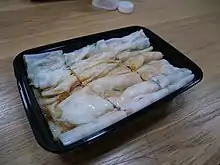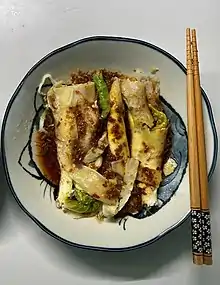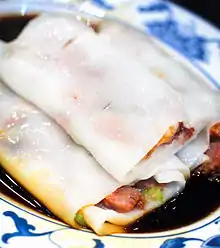Rice noodle roll
A rice noodle roll (also translated as steamed rice roll) is a Cantonese dish from Guangdong Province in southern China and Hong Kong, commonly served either as a snack, small meal or as a variety of dim sum.[1] It is a thin roll made from a wide strip of shahe fen (rice noodles), filled with shrimp, beef, vegetables, or other ingredients. Seasoned soy sauce—sometimes with siu mei drippings—is poured over the dish upon serving. When plain and made without filling, the rice noodle is also known as jyu cheung fan.[2] The name, jyu cheung fan, “jyu” means “pig” in Cantonese, “cheung” means “intestine”, and “fan” means “noodles”. Combining means the pig intestine noodle roll because the appearance of the noodle roll looks like pig's intestine. There is no official recording of the history of the rice noodle roll. Most cooking books mention that the jyu cheung fan was begun in the 1930s. A snack or breakfast that sold in many street restaurants. In Guangzhou, Guangdong Province, people called it laai cheung because it is a noodle roll that pulled or pushed by hand.[3]
 Stone rice noodle rolls | |
| Alternative names | jyu cheung fan, chee cheong fun |
|---|---|
| Course | Dim sum |
| Place of origin | Guangdong |
| Main ingredients | rice noodles |
| Variations | shrimp, pork, beef, or vegetable filling |
| Rice noodle roll | |||||||||||||
|---|---|---|---|---|---|---|---|---|---|---|---|---|---|
| Chinese name | |||||||||||||
| Traditional Chinese | 腸粉 | ||||||||||||
| Simplified Chinese | 肠粉 | ||||||||||||
| Hanyu Pinyin | chángfěn | ||||||||||||
| Cantonese Yale | chéungfán | ||||||||||||
| Literal meaning | Intestine noodle | ||||||||||||
| |||||||||||||
| Alternative Chinese name | |||||||||||||
| Traditional Chinese | 豬腸粉 | ||||||||||||
| Simplified Chinese | 猪肠粉 | ||||||||||||
| Hanyu Pinyin | zhūchángfěn | ||||||||||||
| Cantonese Yale | jyūchèungfán | ||||||||||||
| Literal meaning | Pig intestine noodle | ||||||||||||
| |||||||||||||
| Thai name | |||||||||||||
| Thai | ก๋วยเตี๋ยวหลอด [kǔa̯j.tǐa̯w lɔ̀ːt] | ||||||||||||
| RTGS | kuaitiao lot | ||||||||||||

Preparation
The rice noodle sheets are made from a viscous mixture of 1 cup of rice flour and 1/4 cup tapioca or glutinous rice flour and water; this recipe will scale well as long as the ratio of flours and water remain the same. The combination of both types of flour and water should be a consistency of heavy cream. The rice flour serves as the bulk and flavor of rice, the tapioca flour gives the noodle elasticity and springiness. The tapioca or glutinous rice flour may be omitted when using rice flour made from certain kinds of aged rice, as chemical changes in the aged rice produce the same texture as the addition of the second starch.[4] Either way, it should never crumble nor be too chewy. It should never have the al dente texture as with Italian pasta. Boric acid is sometimes used to make it have a very smooth texture or plastic sheen. Boric acid is banned for human consumption as a food ingredient in the United States, European Union, and developing countries as it may cause kidney failure.
This liquid mixture is poured into a specially made flat pan with holes (similar to a flat colander). Commercial restaurants instead use special oversized steamers that are lined with a steam-permeable cloth. The noodle mixture is steamed in the pan from the bottom up to produce the square rice noodle sheets. The thickness of the noodle should be very thin (roughly 1⁄8 thickness), never thick, or it will have a gummy texture.
Once the liquid mixture is ladled and set, the chef can add a filling such as shrimp or beef before the noodle is fully cooked. As the noodle is cooking, it will start to set around the filling and take hold without falling out when transferring from steamer to dish. After steaming for several minutes, the entire freshly steamed noodle is melded onto the cloth thereby the necessity to be scraped off with a scraper and onto a usually a metal table surface with a thin coat of oil to prevent sticking. The resulting freshly made noodle is lightly folded about three times. The resulting size is usually anywhere from 5 to 7 inches long by 1.5 to 2 inches wide. Traditionally, the noodles are finished with the addition of a warm, sweetened soy sauce just before serving. Cantonese/Hong Kong style Cheungfan is usually lightly folded (about 1.5 to 2 inches wide and 5 to 7 inches long) when there is filling inside, resulting in a much more pleasing look rather than a rolled up as a fruit roll up.
Two common Cantonese words are typically used to describe a well-made rice noodle roll: heung (香; "fragrant") and waat (滑; "smooth"). The actual noodle by itself has little flavor; it is just as bland as plain white steamed rice. The fillings and the soy sauce that accompanies it provides the bulk of the flavor. Traditional fillings are marinated fresh or dried shrimp, beef (heavily mixed with rice flour), or pork and chopped green onions.
As mentioned earlier, presentation is very important when serving dim sum. The rice noodle, when fully cooked, should be slightly transparent to slightly reveal the filling. If the edges after folding are not lined up then the edges are to be cut to get that even look, similar to getting the outer crust cut off a sandwich. The rice noodle roll is generally served in "threes" and usually scored to reveal the filling inside. Most other countries will roll them plain with no filling inside and instead serve them with toppings and a heavy/thick sauce on top. The rice noodle roll is always served hot and fresh and accompanied with a splash of plain or flavored (fried shallot) oil to give it a nice sheen and aroma with a generous amount of warm sweet soy sauce added right before serving. Most establishments will have a slightly different flavor of sweet soy sauce such as an addition of hoisin sauce.
Regional
Cantonese cuisine



In Hong Kong, Malaysia and Singapore, a hugely popular street food is plain cheungfan and is often served with soy sauce, hoisin sauce, sesame sauce and roasted sesame seeds.
In Cantonese cuisine, rice noodle roll is most often served in dim sum. The most common types traditionally offered as part of dim sum cuisine are:
- Beef rice noodle roll (Chinese: 牛肉腸; Cantonese Yale: ngàuyuhk chéung)
- Shrimp rice noodle roll (Chinese: 蝦腸; Cantonese Yale: hā chéung)
- Dried shrimp rice noodle roll (Chinese: 蝦米腸; Cantonese Yale: hā máih chéung)
- Char siu rice noodle roll (Chinese: 叉燒腸; Cantonese Yale: chāsīu chéung)
- Zhaliang (Chinese: 炸兩; Cantonese Yale: ja léung)

Other modern varieties that may be offered include:
- Rice noodle roll with chicken and bitter melon
- Rice noodle roll with conpoy and pea shoot
- Rice noodle roll with fish
- Stir-fried rice noodle roll with XO sauce
A version of cheungfan notably absent outside of Guangzhou is the sliced meat filling variety. This variety is typically found in street side restaurants as a meal in itself, and uses whole meat pieces, typically beef or pork, rather than ground meat. Prior to rolling the crepe, briefly blanched lettuce or romaine is added as part of the filling, giving the cheungfan a crunch as well as volume.
Southeast Asian cuisine
The Malaysian Penang style chee cheong fun is served with a shrimp paste called hae ko in the Hokkien dialect and petis udang in the Malay language.
In Ipoh, chee cheong fun is mainly served in two ways, the dry or wet versions. In the dry version, it is served with bright red sweet sauce and in most cases, chilli sauce as well as pickled green chilli. In the wet version, it is served with curry with pork rind and long bean or minced meat and shiitake mushroom gravy. Both dry or wet versions are topped with sesame seeds and fried shallots.
Teluk Intan, one of the towns in the state of Perak, has other variations of chee cheong fun that contain turnips, shallots and deep-fried shrimp.
Chee cheong fun is a popular breakfast food in Singapore and Malaysia. Chee cheong fun is frequently served in kopitiams and Chinese restaurants. Chee cheong fun can also be found in Bagansiapiapi, a small town in Riau, Indonesia. It is called "tee long pan" or "tee cheong pan" in the Hokkien dialect. Tee long pan is served with red chilli sauce, crushed roasted peanuts, fried onions, and dried shrimp.
Vietnamese cuisine
In Vietnamese cuisine, there is a similar dish called bánh cuốn, and it is mostly eaten for breakfast. It is a crêpe-like roll made from a thin, wide sheet of rice noodle (similar to Shahe fen) that can be filled with ground pork and other ingredients. Sides for this dish usually consist of chả lụa (Vietnamese pork sausage) and bean sprouts, while the dipping sauce is called nước chấm. Sometimes, a drop of cà cuống, which is the essence of a giant water bug, Lethocerus indicus, is added to the nước chấm for extra flavor, although this ingredient is scarce and quite expensive.
References
| Wikimedia Commons has media related to Rice noodle rolls. |
- "晶莹剔透,香滑可口--肠粉". 美食天下 (in Chinese). Retrieved 14 July 2015.
- "的確涼布 拉出完美腸粉". Apple Daily (in Chinese). 2014-08-17. Retrieved 14 July 2015.
- Chee-Beng, Tan (2012-08-01). Chinese Food and Foodways in Southeast Asia and Beyond. NUS Press. ISBN 978-9971-69-548-4.
- Chinese Cooking Demystified (29 January 2019). Cheung Fun, Authentic Cantonese Rice Noodle Rolls (布拉肠粉). YouTube. Retrieved 25 August 2020.